
It's incredibly frustrating to spot a mysterious or flat-out incorrect charge on your credit card statement. The good news? You have the power to fight back. Winning a credit card dispute really comes down to being prepared, persistent, and crystal clear in your communication.
The entire process starts with acting quickly, gathering solid proof, and explaining the situation effectively to your card issuer.
Your Game Plan for a Successful Dispute
Think of challenging a bad charge like building a case. You don’t need a law degree—just a simple, organized approach. The moment you spot an error on your statement, whether it's a duplicate charge, a product that never showed up, or a service that wasn't what was promised, the clock starts ticking.
Your one and only goal is to present a clear, fact-based story to your credit card company that is just too compelling for them to ignore. This isn't about getting into a messy argument with a merchant. It’s about using the consumer protections you are absolutely entitled to. And you’re not alone; millions of people successfully dispute charges every single year.
In 2023, U.S. cardholders disputed a staggering 105 million charges, adding up to an estimated $11 billion. This just goes to show how common—and necessary—this process is for consumers. You can dig into more stats on this growing trend over at eMarketer.
Key Principles for a Winning Strategy
Success almost always hinges on what you do right at the beginning. A disorganized or delayed response can seriously weaken your position before you even get started. To come out of the gate strong, focus on these core principles:
- Act with Urgency: Sure, regulations give you some time, but moving fast shows you’re serious. It also helps ensure all the details are still fresh in your mind. Don't put it off.
- Documentation is Everything: Your claim is only as strong as the proof you provide. Start collecting every email, receipt, screenshot, and note you can find.
- Communicate Clearly: Whether you file your dispute online, over the phone, or by mail, your explanation needs to be concise, factual, and incredibly easy for an investigator to follow.
These foundational steps set the stage for everything that follows. While you're focused on your side, it can also be helpful to understand how merchants approach these situations by learning about credit card chargeback protection.
Before you do anything else, take a look at this quick checklist. These are the immediate actions you should take as soon as you find an incorrect charge.
Your Initial Dispute Action Plan
Getting these first few steps right makes the rest of the process much smoother and significantly increases your odds of a successful outcome.
Why You Shouldn't Contact the Merchant First
It might feel like the polite thing to do—reaching out to the merchant directly to sort things out. But honestly, this can sometimes work against you.
If the charge is clearly fraudulent or you have a feeling the business will be difficult to deal with, your first and most important call should be to your credit card issuer. Initiating a formal dispute right away creates an official record and locks in your protections under the Fair Credit Billing Act (FCBA). This ensures your claim is logged within the required timeframe and immediately shifts the burden of proof to the merchant, giving you a much stronger starting position.
Building an Unbeatable Evidence File
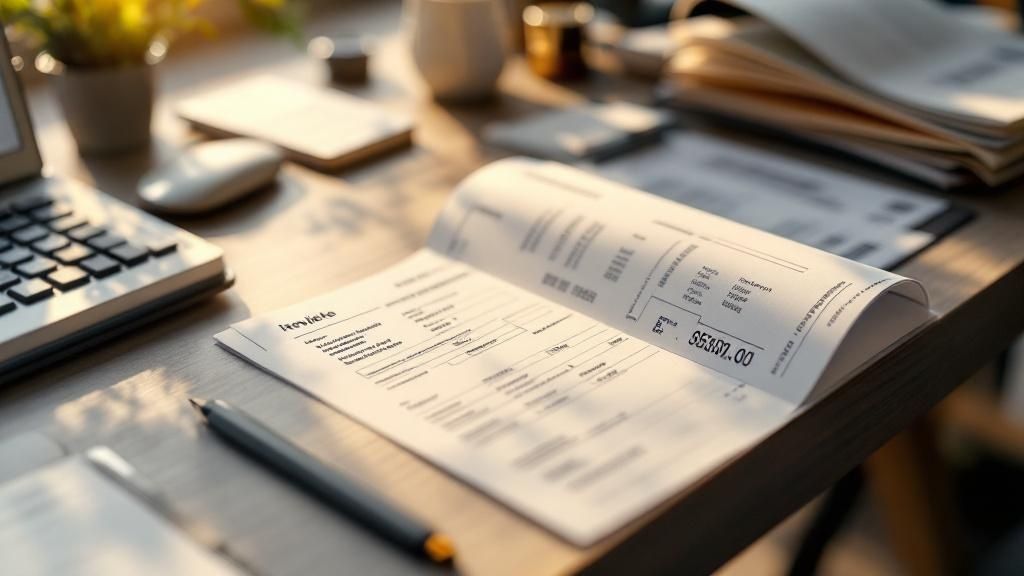
When it's time to dispute a charge, you need to shift your mindset. Think of yourself less as a customer and more as a detective building an ironclad case. Your job is to hand the bank investigator such a clear, compelling story that they can only come to one conclusion: yours.
A solid evidence file is your single most powerful weapon. We're talking about more than just a receipt. A lone receipt rarely tells the whole story and often isn't enough to win. You need to gather every scrap of information that documents the transaction and proves why it's wrong. The more proof you have, the less wiggle room there is for your claim to be denied.
Going Beyond the Obvious Evidence
Let's get practical. You need to think through the entire customer journey, from the moment you first saw the product to every single attempt you made to fix the problem directly with the merchant. Every touchpoint is a potential piece of evidence. Your task is to collect these puzzle pieces and arrange them into a narrative that’s impossible to ignore.
For instance, say you were lured in by a misleading online ad. Simply stating "the ad was misleading" won't cut it. You have to prove it.
- Screenshots are non-negotiable. Snap a screenshot of the product page, the original ad that caught your eye, and any specific claims the merchant made about quality or features.
- Document all communication. Save every email, export every live chat transcript, and screenshot any social media DMs you exchanged with the seller.
- Photos and videos are crucial. If a product arrived damaged or is completely different from what you ordered, take clear photos or a quick video from several angles to show the problem.
This kind of documentation instantly elevates your claim from a "he said, she said" argument to a well-supported case file that an investigator can review and validate in minutes.
Real-World Evidence Scenarios
The right evidence depends entirely on the situation. Disputing a recurring digital subscription you tried to cancel requires different proof than fighting a charge for a defective product.
Here are a few common scenarios and the kind of proof you'd need:
- Product Not as Described: You ordered a wool coat, but a flimsy polyester one showed up. Your best evidence is a side-by-side comparison: a photo of the item you received next to a screenshot of the product page, with the differences circled or highlighted.
- Service Not Rendered: The moving company was a no-show on moving day. Your evidence package should include the booking confirmation email, any reminder texts, and a short, signed statement explaining you were at the location all day and they never arrived.
- Duplicate Charge: You were billed twice for a single dinner. The key evidence is a copy of your credit card statement showing the two identical charges, paired with the single restaurant receipt.
Key Takeaway: The burden of proof is squarely on you. Never assume the bank's investigator will do the digging for you. You need to present them with a neat, organized package containing everything they need. Make their job easy, and you make it easy for them to side with you.
Organizing Your File for Maximum Impact
Once you’ve gathered everything, organization is the final, critical step. A jumbled mess of files and screenshots isn't convincing; it's just confusing. You need to present your evidence in a simple, chronological order that tells a story.
I've found the best way to do this is with a brief cover letter that serves as a roadmap to your evidence. In the letter, refer to each document specifically. For example: "As you can see in Exhibit A (screenshot of the product advertisement)..." or "My attempts to resolve this are documented in Exhibit B (email chain with customer service)..." This structure makes your argument focused and powerful.
It's interesting to note that geography can play a role in these disputes. Consumer protection laws in North America are quite strong, leading to a huge volume of chargebacks. While the region makes up about 92.66% of transactions, it accounts for a staggering 96.9% of all global chargebacks.
This proactive, evidence-first approach is especially vital when dealing with friendly fraud—cases where a customer disputes a charge they actually made. If you want to dive deeper into this specific issue, you can check out our guide on friendly fraud. At the end of the day, a rock-solid evidence file is your ultimate defense.
Writing a Dispute Letter That Gets Results
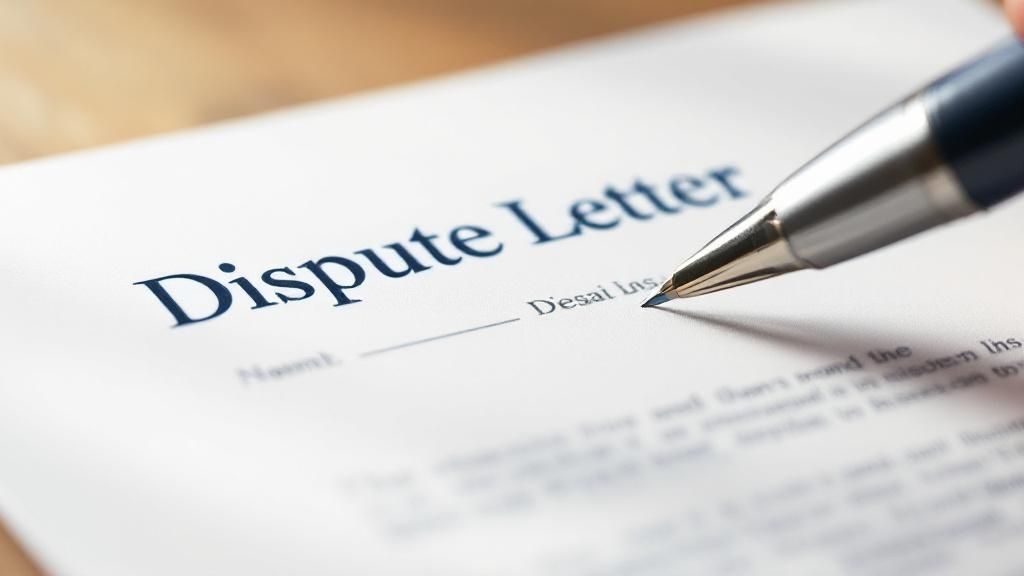
You’ve gathered your evidence. Now it's time to put your case into words.
While you can often kick off a dispute online or over the phone, I always recommend following up with a formal, well-written letter. It creates a critical paper trail and, frankly, shows the card issuer you're serious and organized.
Forget those generic, fill-in-the-blank templates floating around the internet. A powerful dispute letter is personal and specific. It needs to command attention and lay out the facts so clearly that the investigator has an easy path to follow. The goal here is to be firm and professional, not angry or emotional.
Your letter should walk the investigator through the timeline of events, point to each piece of evidence you've gathered, and state exactly what you want—which is almost always a full refund for the disputed amount.
Crafting a Professional and Firm Tone
The most effective dispute letters I’ve seen are calm, factual, and direct. Venting your frustration might feel good in the moment, but it can cloud your message and make you seem less credible.
Remember, the person reading your letter is just doing their job. They weren't involved in the original transaction. Your mission is to make their decision as easy as possible by presenting an undeniable case, not by making them feel your anger.
Use simple, clear language. State the facts chronologically. Let your evidence do the talking instead of making accusations about the merchant.
A well-argued letter paired with strong evidence is the one-two punch that wins disputes. The tone sets the stage, and the facts deliver the knockout.
Key Components of a Winning Letter
Every strong dispute letter is built on a solid foundation. To give the investigator a clear and compelling narrative, make sure you include these essential pieces of information:
- Your Account Info: Start with your full name, address, and the credit card account number in question.
- The Problem Transaction: Clearly identify the charge. You'll need the merchant's name, the transaction date, and the exact dollar amount.
- A Quick Summary: In one or two sentences, get straight to the point. For example, "I am disputing this charge because the product I received was defective and did not match the website's description."
- The Full Story: Lay out the sequence of events in chronological order. Detail when you made the purchase, when you received the item (or didn't), and every attempt you made to solve the problem directly with the merchant.
- Reference Your Proof: This is crucial. Explicitly call out the documents you’ve included. For instance, "Please see Exhibit A for a copy of my order confirmation and Exhibit B for photos showing the damage."
- Your Desired Outcome: End with a clear, direct request. "I am requesting a full credit of $149.99 to my account for this transaction."
This structure turns a simple complaint into a formal request for action, which is exactly what gets results. This principle applies across different payment platforms, too. For instance, you can see similar strategies in our guide on how to chargeback on PayPal and win.
Examples for Different Scenarios
Let's look at how you might phrase the core of your argument for a couple of common situations.
Here's an example for an item that never showed up.
Example for "Product Not Received"
"On October 15, 2023, I purchased a pair of headphones from XYZ Electronics (see Exhibit A: Order Confirmation). The tracking number they provided has shown no updates for over four weeks. My emails to their customer service on November 1st and November 8th went unanswered (see Exhibit B: Email Screenshots). As the product was never delivered, I request a full refund."
This works because it's concise, references specific dates and evidence, and has a clear call to action. It gives the bank everything it needs to move forward.
The same logic applies to services you paid for but never got.
Example for "Service Not Delivered"
"I hired 'Quick Cleaners' for a home cleaning service scheduled for November 10, 2023, and have attached the service agreement as Exhibit A. The company was a no-show at the scheduled time, and my calls to their office have not been returned. I am requesting a full reversal of the $250 service charge."
By tailoring your letter to your specific situation and backing it up with organized evidence, you dramatically improve your chances of winning.
One last tip from experience: always send your letter via certified mail with a return receipt requested. This gives you undeniable proof of when the bank received your formal dispute, which can be critical if there are any questions about timelines later on.
What Happens After You File Your Dispute?
So, you’ve put in the work, gathered your evidence, and sent off your dispute letter. Now what? This part—the waiting—can feel like the most frustrating part of the whole process if you don’t know what’s happening behind the scenes.
Once you file a dispute, the clock starts ticking for your credit card issuer. Thanks to the Fair Credit Billing Act (FCBA), they are legally required to investigate your claim and resolve it within two complete billing cycles, which can't be more than 90 days from when they got your complaint. This window gives them time to talk to the merchant and look at the evidence from both sides.
This whole journey has a few key stages, from the moment you spot the charge to the day you get a final decision.
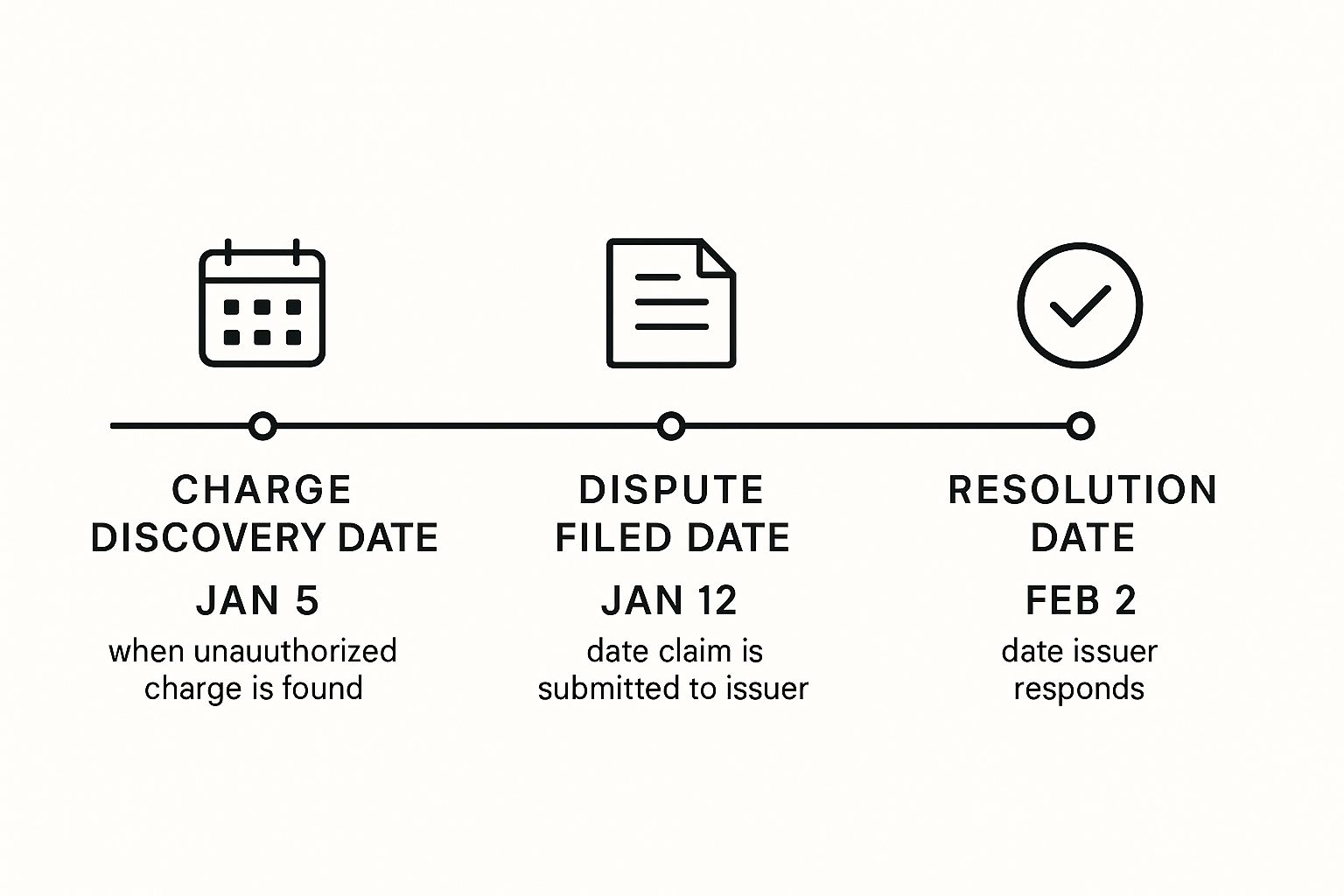
As you can see, it's a step-by-step process. It takes time because it involves coordination between you, your bank, and the merchant.
The Magic of Provisional Credit
One of the first things you'll probably see after filing is a provisional credit on your account. This is just a temporary refund for the disputed amount that your card issuer posts while they sort things out.
Seeing that credit is a good sign—it means the process is officially underway. But it’s really important to remember that this credit is temporary. If the final decision goes in the merchant's favor, your bank will reverse the credit, and that charge will pop right back onto your statement.
My advice? Pretend that money isn't there. It's best to leave it completely untouched until you get a final, official letter saying the dispute was resolved for you. This way, you won't get caught off guard if the decision doesn't go your way.
The Investigation Timeline and What to Expect
The back-and-forth between banks and the merchant follows a fairly standard timeline. Knowing the key stages helps you understand where your case is and what's coming next.
Below is a table breaking down the typical process from start to finish.
| Dispute Process Timeline and Key Stages |
| :--- | :--- | :--- |
| Stage | Typical Duration | What Happens During This Stage |
| Submission | 1-3 Days | Your bank receives your dispute and assigns it a case number. You'll usually get an acknowledgment letter or email. |
| Initial Review | 5-10 Days | Your bank reviews your evidence. A provisional credit for the disputed amount is often issued to your account at this stage. |
| Merchant Notification | 10-20 Days | Your bank forwards the dispute to the merchant's bank (the acquirer), who then notifies the merchant of your claim. |
| Merchant Response | Up to 30 Days | The merchant has a window to respond with their own evidence to prove the charge was valid. This is called representment. |
| Final Decision | 60-90 Days | Your bank weighs all the evidence from both sides and makes a final call. You'll be notified of the outcome by mail. |
This timeline gives you a roadmap, but remember that the exact timing can vary a bit depending on the complexity of your case and the banks involved.
Keeping Tabs on Your Case
It’s completely normal to want an update, but you don't want to call every other day. A good rule of thumb is to wait at least 30 days before making your first follow-up call. When you do, just be polite, provide your case number, and ask for a quick status update.
If you’re getting close to that 90-day mark and still haven't heard anything, it's time to be a bit more assertive. A firm but professional call or a follow-up letter is perfectly fine at this point.
Interestingly, the size of the charge can play a role in how things shake out. Data shows that for smaller charges under $29.99, the consumer win rate is a solid 46.85%. But for larger disputes of $300 or more, that rate drops to 27.64%. This is likely because merchants are far more motivated to fight for those higher-value sales. These chargeback statistics really highlight why having a rock-solid case is so crucial, no matter the dollar amount.
What to Do If Your Dispute Is Denied
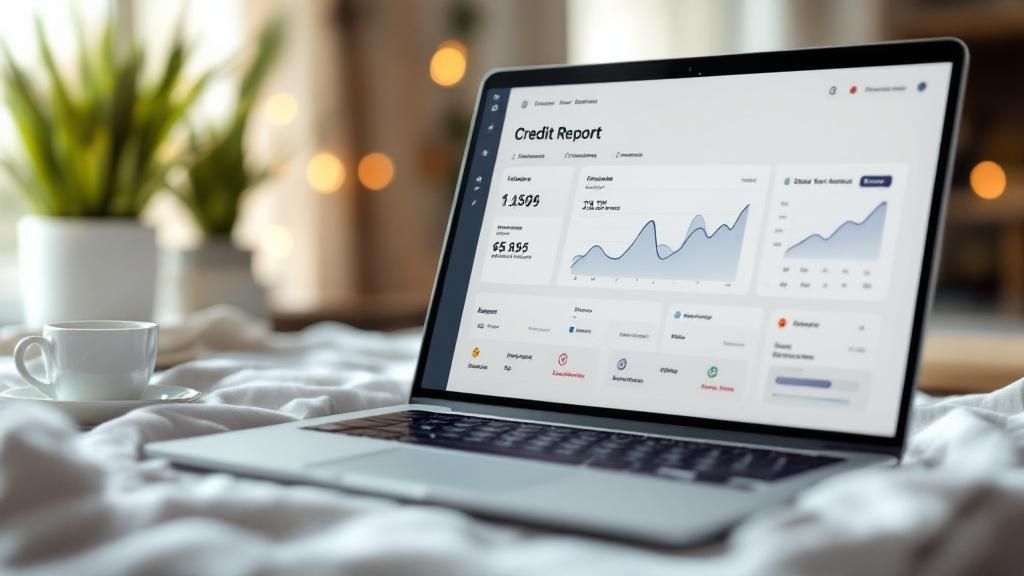
Getting that letter saying your credit card dispute was denied is a gut punch. It’s easy to feel like you’ve hit a brick wall, but trust me, this is rarely the end of the road. More often than not, a denial is just another step in the process, not the final word.
The most important thing right now is to shake off the disappointment. Your immediate goal is to find out exactly why the bank sided with the merchant. Understanding their reasoning is the key that unlocks your next move and helps you figure out how to win on the second try.
Uncovering the Reason for the Denial
Your card issuer is legally required to give you a written explanation for their decision. If the denial notice you got was vague, your first move is to formally request that detailed explanation.
Sometimes a quick phone call can get you the answer, but I always recommend following up with a written request. It creates a paper trail. In your letter or email, make sure to reference your original case number and clearly state that you're requesting the specific reasons for the denial.
In my experience, a denial almost always boils down to one of two things:
- Insufficient Evidence: You might have missed a crucial piece of proof the investigator was looking for. Maybe they needed to see your emails trying to contact the merchant or a clearer picture of the defective product.
- The Merchant's Rebuttal: The merchant successfully argued their case with their own evidence. It's common for them to provide proof of delivery or a copy of the terms and conditions you supposedly agreed to.
Once you have that explanation, you can see exactly where the weak spot in your original case was and start building a much stronger argument.
Re-Evaluating Your Evidence and Strategy
With the bank's reasoning in hand, it’s time to pull out your evidence file again. Look at everything through the investigator's eyes. What was missing? Did the merchant provide a document that directly contradicts your claim?
This is your opportunity to fill in those gaps. For example, if the merchant claimed you never tried to return the item, now you can fire back with screenshots of your emails or phone records showing your calls to their customer service line. If they questioned the damage, you could even get a short, written opinion from a third-party expert, like a local repair shop.
Key Insight: A denial isn't a judgment on whether you were "right" or "wrong." It’s a judgment on the evidence that was presented. Your job now is to upgrade your evidence for the appeal.
Sometimes, the denial actually reveals a misunderstanding of policies on the merchant's side. They might have a strict "no refunds" policy, but that doesn't just magically override your right to dispute a charge for a product that never showed up. Understanding the common reasons a merchant might refuse a chargeback gives you valuable insight into how to dismantle their arguments.
Exploring Your Next Steps
If your first dispute gets rejected, don't assume the first "no" is final. You still have several powerful options available.
Here are your main paths forward:
Appeal the Decision: This is your most direct route. You’ll submit a new letter to your card issuer, specifically addressing the reasons they gave for the denial and providing your new, more compelling evidence. Make sure to clearly label it as an "Appeal."
Escalate to Arbitration: If the appeal doesn't work, you can request arbitration. This is a more formal process where the card network itself (like Visa or Mastercard) acts as a neutral third party to review the entire case. Just be aware that this can sometimes involve fees, which you may or may not get back if you win.
File a Complaint with the CFPB: The Consumer Financial Protection Bureau (CFPB) is a U.S. government agency that exists to protect consumers like you. Filing a complaint is free and surprisingly straightforward. The CFPB forwards your complaint directly to the card issuer, who is then required to respond. This external pressure is often exactly what's needed to get the bank to take a second, more serious look at your case.
Knowing these options are on the table gives you serious leverage. It signals to the card issuer that you're informed, you're serious about your consumer rights, and you aren't just going to go away. That alone can be a powerful motivator for them to reconsider and work toward a fair outcome.
Common Questions About Credit Card Disputes
When you're staring down a frustrating charge on your statement, you’re bound to have questions. It's a lot easier to handle a dispute when you know the rules of the game. Let's walk through some of the most common things people ask, so you can tackle the process with a bit more confidence.
A question I get a lot is whether it's worth bothering the merchant before filing a formal dispute.
Should I Contact the Merchant First?
Yes, it’s almost always a good idea. A quick call or email to the business that charged you can often clear things up fast. Many issues are just simple mistakes—a classic double charge or a simple data entry error—that a manager can fix right on the spot. This saves you the headache of a formal dispute process.
However, there are exceptions. If the charge is clearly fraudulent (you've never even heard of the merchant) or if the business is uncooperative right out of the gate, don't waste your time. Go straight to your card issuer. Just be sure to note when you called or emailed; that documentation becomes excellent evidence for your case.
Another big worry for many is the potential fallout for their financial health.
Will a Dispute Hurt My Credit Score?
Nope. Filing a credit card dispute will not directly harm your credit score. This is a consumer right, protected by the Fair Credit Billing Act, and it’s not something that gets reported to credit bureaus like Experian or Equifax.
The most important thing is to continue paying your credit card bill on time, minus the amount you're disputing. Your issuer will typically put a hold on payment requirements for that specific charge while it's under investigation, so you won't get hit with late fees or interest on that amount.
Key Insight: Don't let fear of a credit score ding stop you. Disputing a charge is a protected consumer action. The real risk comes from not paying the undisputed parts of your bill.
Knowing the timelines is also critical. You can't wait forever.
How Long Do I Have to Dispute a Charge?
Officially, the Fair Credit Billing Act gives you 60 days to dispute a charge, starting from the day the statement with the error was mailed. But in practice, the major card networks like Visa and Mastercard often give you a more generous window, sometimes up to 120 days from the actual transaction date.
My advice? Don't wait. The sooner you act, the stronger your case looks. Moving quickly shows you're on top of your finances and helps ensure all the details are still fresh in your mind.
Finally, people often wonder if they can just cut ties and walk away from the account.
Can I Close My Account During a Dispute?
You technically can, but it's a really bad idea. Closing your account smack in the middle of an investigation can seriously complicate things or even stop the process cold.
Once that account is closed, your card issuer might no longer be obligated to pursue the dispute for you. It's always best to keep the account open and in good standing until the investigation is completely finished and any credit has been permanently applied to your account. For a deeper look into the operational side of disputes, learning about what is chargeback management can provide valuable context.
At ChargePay, we believe merchants shouldn't have to lose revenue to fraudulent claims. Our AI-powered solution automates the entire dispute process, crafting winning evidence-based responses to recover your funds without you lifting a finger. See how ChargePay can boost your win rate and protect your bottom line at https://www.chargepay.ai.
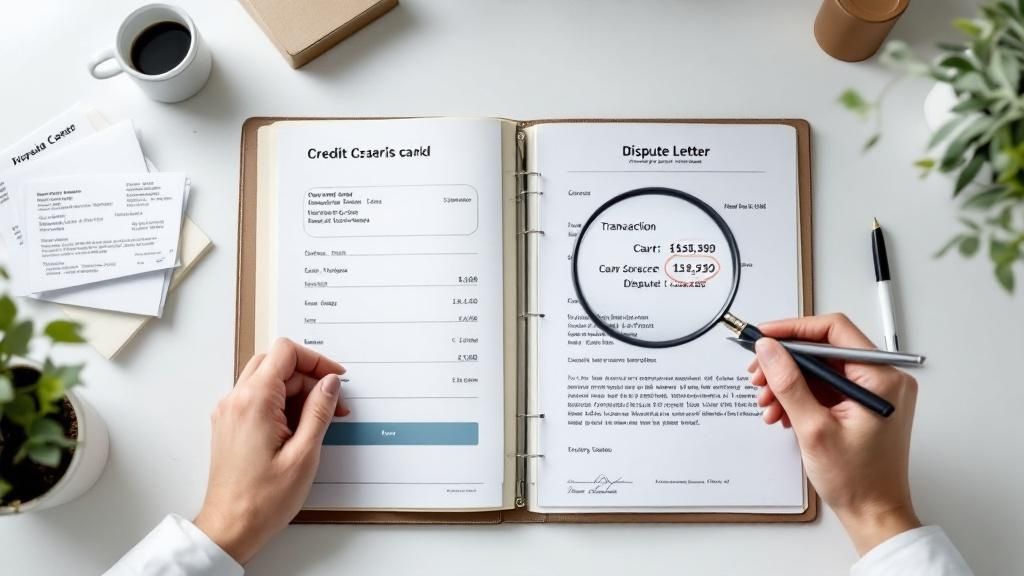






.svg)







.svg)
.svg)
.svg)